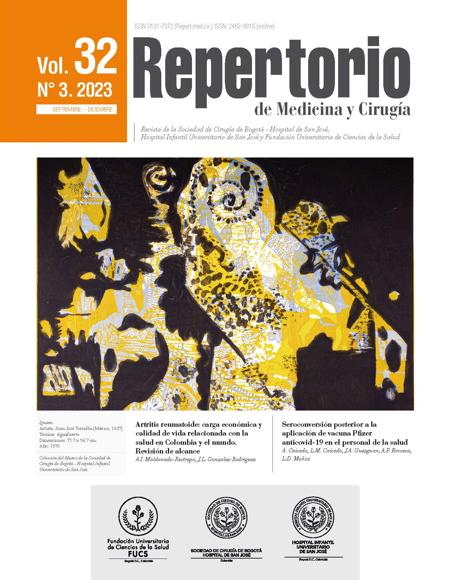Potentially inappropriate medications for older adults in the internal medicine service
Medicamentos potencialmente inapropiados para el adulto mayor en el servicio de medicina interna
![]()
![]()

Show authors biography
Introduction: inappropriate drug prescribing is defined as the use of medicines whose risks outweigh their benefits, or when there is increased potential of drug-drug interactions. The Beers and PRISCUS criteria were developed as tools to prevent potentially inappropriate medication (PIM) in the elderly. Objective: to identify PIM in the elderly population who attended the internal medicine service of Hospital Universitario Hernando Moncaleano Perdomo, by means of the Beers and PRISCUS criteria. Materials and methods: a descriptive, observational, cross-sectional study in patients over age 65. The sample size was calculated in 357 patients. Excel version 2013 was used for data storage. EPI INFO version 7.1.4 was used for data analysis. Results: mean age 75 years, males 52.66%, average number of drugs per patient 8.77 (SD +/- 5). Heart failure was the most common diagnosis (29 cases - 8.12 %). According to the Beers criteria, PIM was identified in 4.9% of patients; metoclopramide (20%) and amiodarone (14%) being the most prescribed. The PRISCUS list identified PIM in 2.5%; prazosin (20%) being the most prescribed. Conclusions: the drugs identified by the BEERS criteria were metoclopramide, amiodarone, prazosin, and beta-methyl digoxin. Prazosin, haloperidol, beta-methyl digoxin, and diphenhydramine were identified by the PRISCUS criteria.
Article visits 560 | PDF visits 1778
Downloads
- Asmamaw G, Ejigu N, Tewihubo D, Ayenew W. Assessment of private health sector prescribing patterns and adherence to prescription format using World Health Organization core drug use indicators in Addis Ababa, Ethiopia. J Pharm Policy Pract. 2022;15(1):11. https://doi.org/10.1186/s40545-022-00408-0. DOI: https://doi.org/10.1186/s40545-022-00408-0
- Zhou L, Shi H, Cheng R, Ge M, Hu F, Hou L, et al. Potential association between frailty and pTau in community-dwelling older adults. BMC Geriatr. 2022;22(1):770. https://doi.org/10.1186/s12877-022-03454-0. DOI: https://doi.org/10.1186/s12877-022-03454-0
- Gronich N, Abernethy D. Farmacología en el continuo de la edad. En: Waldman SA, Terzic A, editores. Farmacología y terapéutica, principios de la práctica clínica. México: Manual Moderno; 2010. p. 257-263
- O'Caoimh R, Cornally N, McGlade C, Gao Y, O'Herlihy E, et al. Reducing inappropriate prescribing for older adults with advanced frailty: A review based on a survey of practice in four countries. Maturitas. 2019;126:1–10. https://doi.org/10.1016/j.maturitas.2019.04.212. DOI: https://doi.org/10.1016/j.maturitas.2019.04.212
- De Ruiter SC, Biesheuvel SS, van Haelst IMM van Marum RJ, M Jansen RW. To STOPP or to START? Potentially inappropriate prescribing in older patients with falls and syncope. Maturitas. 2020;131:65–71. https://doi.org/10.1016/j.maturitas.2019.10.013. DOI: https://doi.org/10.1016/j.maturitas.2019.10.013
- American Geriatrics Society Beers Criteria. American Geriatrics Society 2019 Updated AGS Beers Criteria for Potentially Inappropriate Medication Use in Older Adults. Journal of the American Geriatrics Society. 2019;67(4):674-94. https://doi.org/10.1111/jgs.15767. DOI: https://doi.org/10.1111/jgs.15767
- Muhammad K, Amin MU, Khan FU, Ismael NS, Sabi-UrRehman, Ahmed A, Saqlain A, Butt MH, Latif MS, Kamran M. Prescription Analysis of Outpatients in a Tertiary Care Hospital in Khyber Pakhtunkhwa, Pakistan. Trop J Nat Prod Res. 2021;5(4):643-648. https://doi.org/10.26538/tjnpr/v5i4.9. DOI: https://doi.org/10.26538/tjnpr/v5i4.9
- Mai Nguyen TN, Clarissa Laetsch D, Chen LJ, et al. Comparison of Five Lists to Identify Potentially Inappropriate Use of Non-Steroidal Anti-Inflammatory Drugs in Older Adults. Pain Med. 2021;22(9):1962–1969. https://doi.org/10.1093/pm/pnaa480. DOI: https://doi.org/10.1093/pm/pnaa480
- American Geriatrics Society Beers Criteria Update Expert P. American Geriatrics Society 2015 Updated Beers Criteria for Potentially Inappropriate Medication Use in Older Adults. J Am Geriatr Soc. 2015;63(11):2227-2246. https://doi.org/10.1111/jgs.13702. DOI: https://doi.org/10.1111/jgs.13702
- Roux B, Sirois C, Simard M, Gagnon ME, Laroche ML. Reply to Potentially inappropriate medication use in older adults: a reply to Amorim et al. Fam Prac. 2021;38(2):191-192. https://doi.org/10.1093/fampra/cmaa098. DOI: https://doi.org/10.1093/fampra/cmaa098
- Aronson JK. 'Drug–drug interactions'. In: Camm AJ, Lüscher TF, Maurer G, Serruys PW (ed.). The ESC Textbook of Cardiovascular Medicine. United Kingdom: Oxford University Press; 2021. p.227–233. https://doi.org/10.1093/med/9780198784906.003.0044_update_001. DOI: https://doi.org/10.1093/med/9780198784906.003.0044_update_001
- Odhayani AA, Tourkmani A, Alshehri M, Alqahtani H, Mishriky A. Potentially inappropriate medications prescribed for elderly patients through family physicians. Saudi J Biol Sci. 2017;24(1):200-207. https://doi.org/10.1016/j.sjbs.2016.05.006. DOI: https://doi.org/10.1016/j.sjbs.2016.05.006
- Burningham Z, Jackson GL, Kelleher J, Stevens M, et al. The Enhancing Quality of Prescribing Practices for Older Veterans Discharged From the Emergency Department (EQUIPPED) Potentially Inappropriate Medication Dashboard: A Suitable Alternative to the In-person Academic Detailing and Standardized Feedback Reports of Traditional EQUIPPED?. Clin Ther. 2020;42(4):573-582. https://doi.org/10.1016/j.clinthera.2020.02.013. DOI: https://doi.org/10.1016/j.clinthera.2020.02.013
- Castro Ramírez JA, Orozco Hernández JPP, Marin Medina DS. Polifarmacia y prescripción de medicamentos potencialmente no apropiados en ancianos. Rev Méd Risaralda. 2015;21(2). https://doi.org/10.22517/25395203.12451.
- Agüirre-Cardona M, Cardona-Echeverri DM, García-Maürno MA, García-Ospina DA, Gutiérrez-Osorio EA, Castrillón-Spitia JD. Prescription-indication of proton pump inhibitors. Cost of inadequate prescription in a first level institution in Colombia. Acta Med Colomb. 2018;43(4):183-91. https://doi.org/10.36104/amc.2018.1264. DOI: https://doi.org/10.36104/amc.2018.1264
- Molina O, Amariles P, Angulo N. Listado de medicamentos trazadores/señaladores como herramienta en programas de seguimiento farmacoterapéutico o de farmacoseguridad. Acta Méd Colomb. 2017;42(1):42-54. https://doi.org/10.36104/amc.2017.773. DOI: https://doi.org/10.36104/amc.2017.773
- Lucchetti G, Lucchetti LGA. Inappropriate prescribing in older persons: A systematic review of medications available in different criteria. Arch Gerontol Geriatr. 2017;68:55–61. https://doi.org/10.1016/j.archger.2016.09.003. DOI: https://doi.org/10.1016/j.archger.2016.09.003
- Bony H, Lloyd RA, Hotham ED, Corre LJ, et al. Diferences in the prescribing of potentially inappropriate medicines in older Australians comparison of community dwelling and residential aged care residents. Sci Rep. 2020;10(1):10170. https://doi.org/10.1038/s41598-020-66991-x. DOI: https://doi.org/10.1038/s41598-020-66991-x
- Pardo-Cabello AJ, Manzano-Gamero V, Zamora-Pasadas M, et al. Potentially inappropriate prescribing according to STOPP-2 criteria among patients discharged from Internal Medicine: prevalence, involved drugs and economic cost. Arch Gerontol Geriatr. 2018;74:150–154. https://doi.org/10.1016/j.archger.2017.10.009. DOI: https://doi.org/10.1016/j.archger.2017.10.009
- Avanthi J, Chung Y, Jabbarpour Y. Primary Care Physician Characteristics Associated with Prescribing Potentially Inappropriate Medication for Elderly Patients: Medicare Part D Data. J Am Board Fam Med. 2020;33(4):561-568. https://doi.org/10.3122/jabfm.2020.04.190310. DOI: https://doi.org/10.3122/jabfm.2020.04.190310
- Chiapella LC, Montemarani MJ, Mamprin ME. Potentially Inappropriate Medications in Elderly Ambulatory Patients: A Comparative Study between a Primary Health Care Center and a Community Pharmacy. Value Health Reg Issues. 2018;17:119–125. https://doi.org/10.1016/j.vhri.2017.12.009. DOI: https://doi.org/10.1016/j.vhri.2017.12.009
- Vatcharavongvan P, Puttawanchai V. Potentially inappropriate medications among the elderly in primary care in Thailand from three different sets of criteria. Pharm Pract. 2019;17(3):1494. https://doi.org/10.18549/PharmPract.2019.3.1494. DOI: https://doi.org/10.18549/PharmPract.2019.3.1494












